Development of a Draft Research Proposal on TCIM in Medical School
VerifiedAdded on 2023/03/20
|10
|2031
|42
Report
AI Summary
This report is a research proposal focusing on the integration of Traditional Chinese Integrative Medicine (TCIM) into medical school curricula. It begins with an introduction and summary, outlining the problem, research purpose, and significance, followed by a literature review that explores the historical context and current trends in TCIM. The proposal details the study's aims and objectives, project narrative including methods, procedures, evaluation, and dissemination plans. The research employs questionnaires for data collection. The objectives include assessing the applicability of TCIM alongside modern medicine. The proposal concludes with a budget overview and a discussion of the potential benefits and implications of integrating TCIM into medical education. The report also provides a list of references.
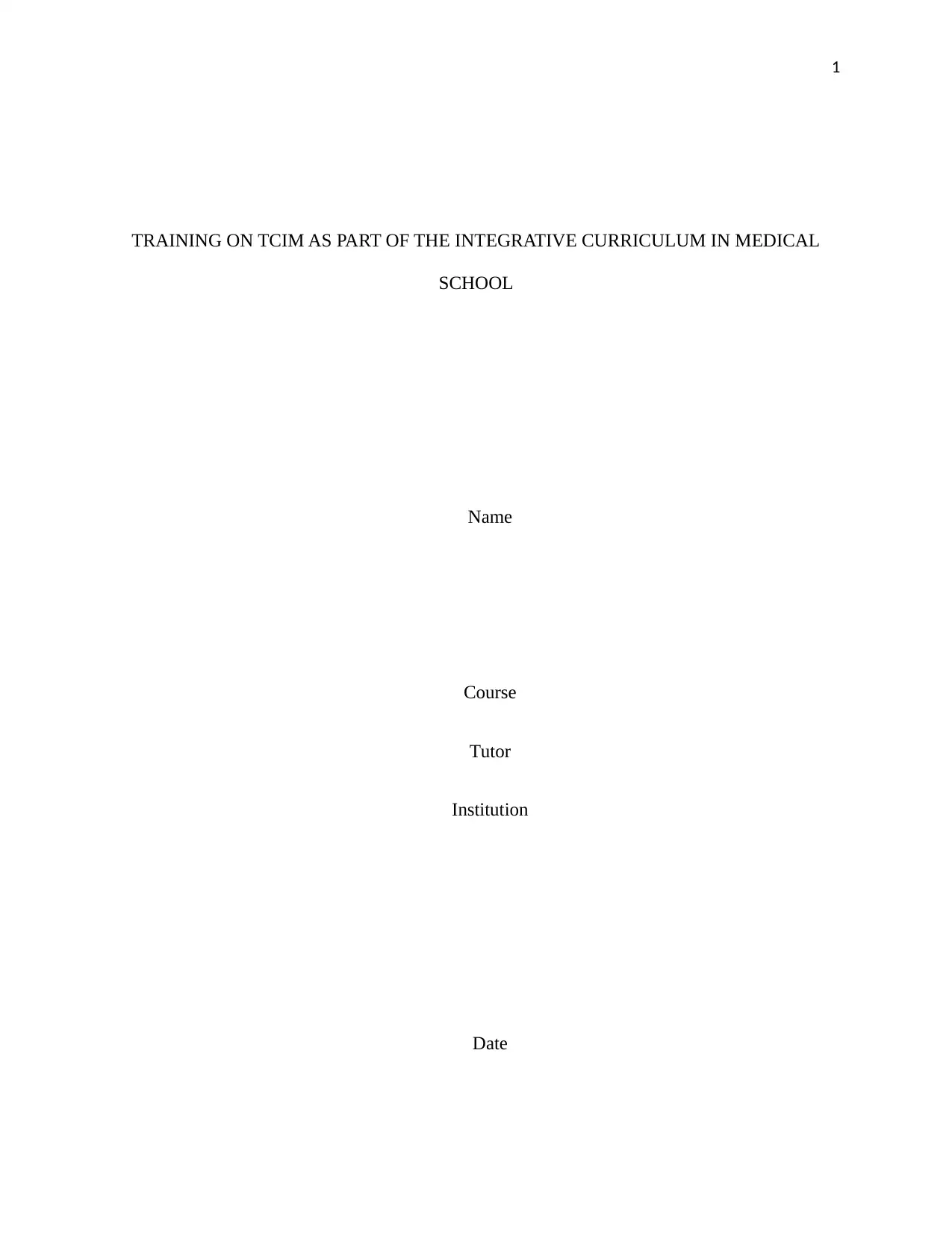
1
TRAINING ON TCIM AS PART OF THE INTEGRATIVE CURRICULUM IN MEDICAL
SCHOOL
Name
Course
Tutor
Institution
Date
TRAINING ON TCIM AS PART OF THE INTEGRATIVE CURRICULUM IN MEDICAL
SCHOOL
Name
Course
Tutor
Institution
Date
Paraphrase This Document
Need a fresh take? Get an instant paraphrase of this document with our AI Paraphraser
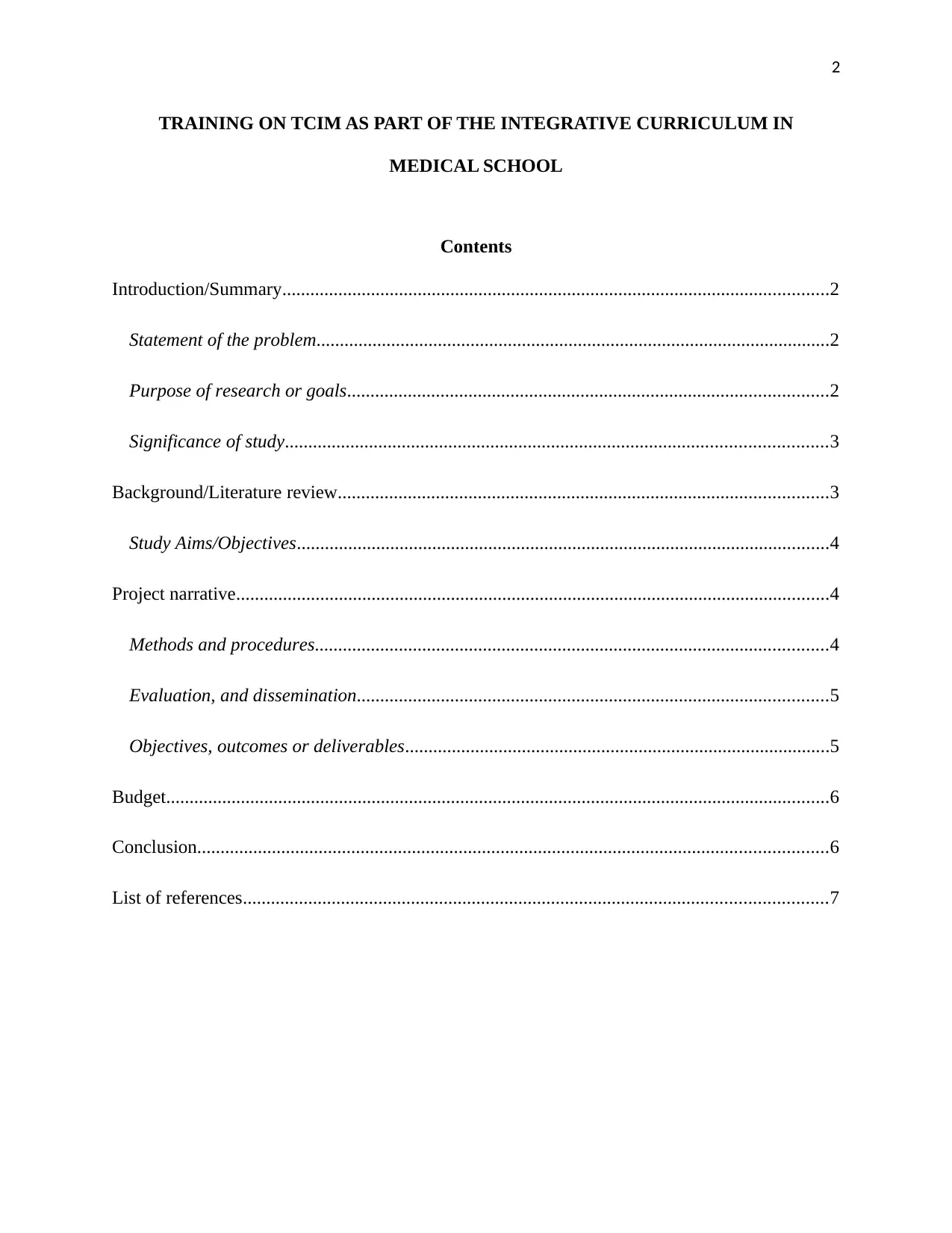
2
TRAINING ON TCIM AS PART OF THE INTEGRATIVE CURRICULUM IN
MEDICAL SCHOOL
Contents
Introduction/Summary.....................................................................................................................2
Statement of the problem..............................................................................................................2
Purpose of research or goals.......................................................................................................2
Significance of study....................................................................................................................3
Background/Literature review.........................................................................................................3
Study Aims/Objectives..................................................................................................................4
Project narrative...............................................................................................................................4
Methods and procedures..............................................................................................................4
Evaluation, and dissemination.....................................................................................................5
Objectives, outcomes or deliverables...........................................................................................5
Budget..............................................................................................................................................6
Conclusion.......................................................................................................................................6
List of references.............................................................................................................................7
TRAINING ON TCIM AS PART OF THE INTEGRATIVE CURRICULUM IN
MEDICAL SCHOOL
Contents
Introduction/Summary.....................................................................................................................2
Statement of the problem..............................................................................................................2
Purpose of research or goals.......................................................................................................2
Significance of study....................................................................................................................3
Background/Literature review.........................................................................................................3
Study Aims/Objectives..................................................................................................................4
Project narrative...............................................................................................................................4
Methods and procedures..............................................................................................................4
Evaluation, and dissemination.....................................................................................................5
Objectives, outcomes or deliverables...........................................................................................5
Budget..............................................................................................................................................6
Conclusion.......................................................................................................................................6
List of references.............................................................................................................................7
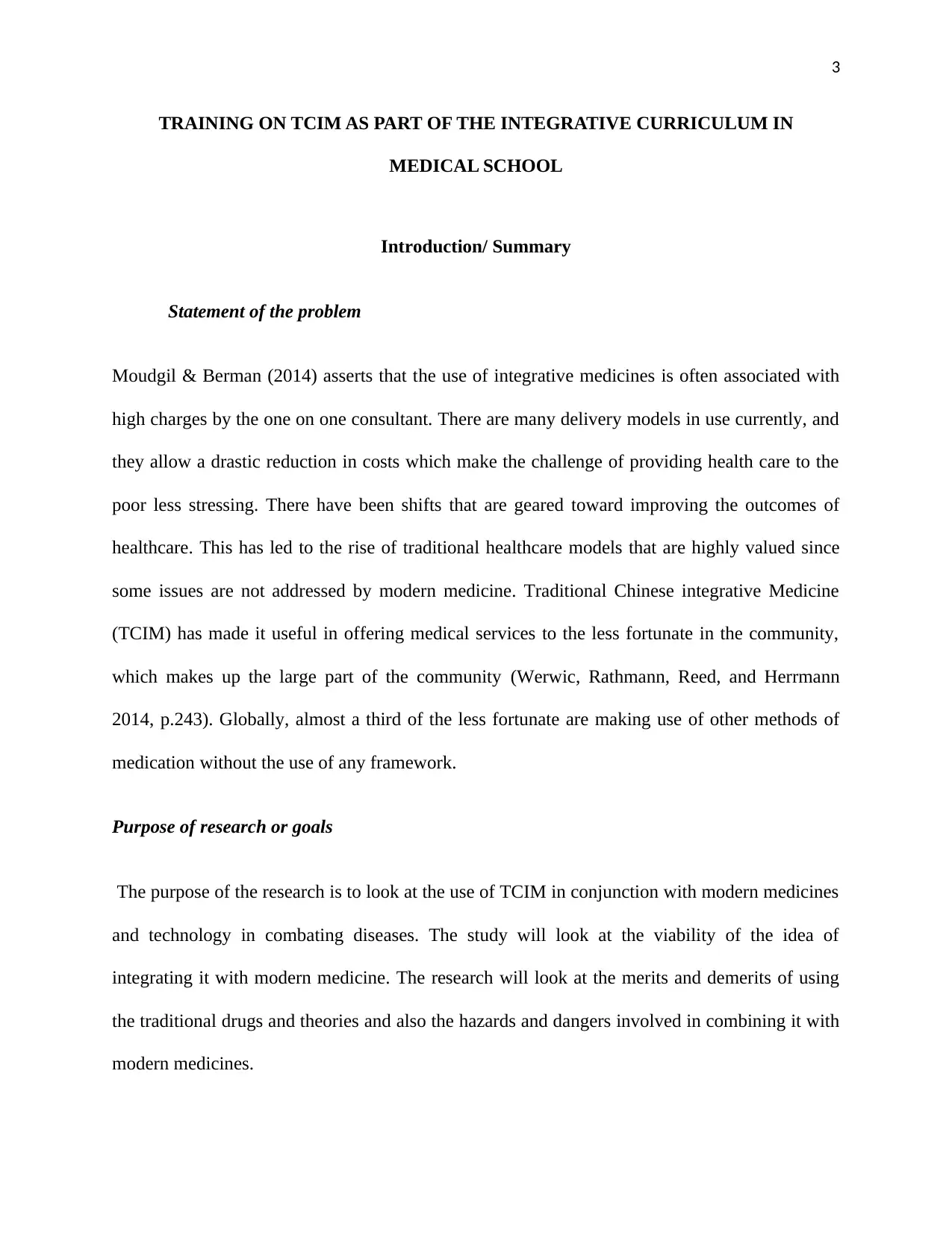
3
TRAINING ON TCIM AS PART OF THE INTEGRATIVE CURRICULUM IN
MEDICAL SCHOOL
Introduction/ Summary
Statement of the problem
Moudgil & Berman (2014) asserts that the use of integrative medicines is often associated with
high charges by the one on one consultant. There are many delivery models in use currently, and
they allow a drastic reduction in costs which make the challenge of providing health care to the
poor less stressing. There have been shifts that are geared toward improving the outcomes of
healthcare. This has led to the rise of traditional healthcare models that are highly valued since
some issues are not addressed by modern medicine. Traditional Chinese integrative Medicine
(TCIM) has made it useful in offering medical services to the less fortunate in the community,
which makes up the large part of the community (Werwic, Rathmann, Reed, and Herrmann
2014, p.243). Globally, almost a third of the less fortunate are making use of other methods of
medication without the use of any framework.
Purpose of research or goals
The purpose of the research is to look at the use of TCIM in conjunction with modern medicines
and technology in combating diseases. The study will look at the viability of the idea of
integrating it with modern medicine. The research will look at the merits and demerits of using
the traditional drugs and theories and also the hazards and dangers involved in combining it with
modern medicines.
TRAINING ON TCIM AS PART OF THE INTEGRATIVE CURRICULUM IN
MEDICAL SCHOOL
Introduction/ Summary
Statement of the problem
Moudgil & Berman (2014) asserts that the use of integrative medicines is often associated with
high charges by the one on one consultant. There are many delivery models in use currently, and
they allow a drastic reduction in costs which make the challenge of providing health care to the
poor less stressing. There have been shifts that are geared toward improving the outcomes of
healthcare. This has led to the rise of traditional healthcare models that are highly valued since
some issues are not addressed by modern medicine. Traditional Chinese integrative Medicine
(TCIM) has made it useful in offering medical services to the less fortunate in the community,
which makes up the large part of the community (Werwic, Rathmann, Reed, and Herrmann
2014, p.243). Globally, almost a third of the less fortunate are making use of other methods of
medication without the use of any framework.
Purpose of research or goals
The purpose of the research is to look at the use of TCIM in conjunction with modern medicines
and technology in combating diseases. The study will look at the viability of the idea of
integrating it with modern medicine. The research will look at the merits and demerits of using
the traditional drugs and theories and also the hazards and dangers involved in combining it with
modern medicines.
⊘ This is a preview!⊘
Do you want full access?
Subscribe today to unlock all pages.

Trusted by 1+ million students worldwide
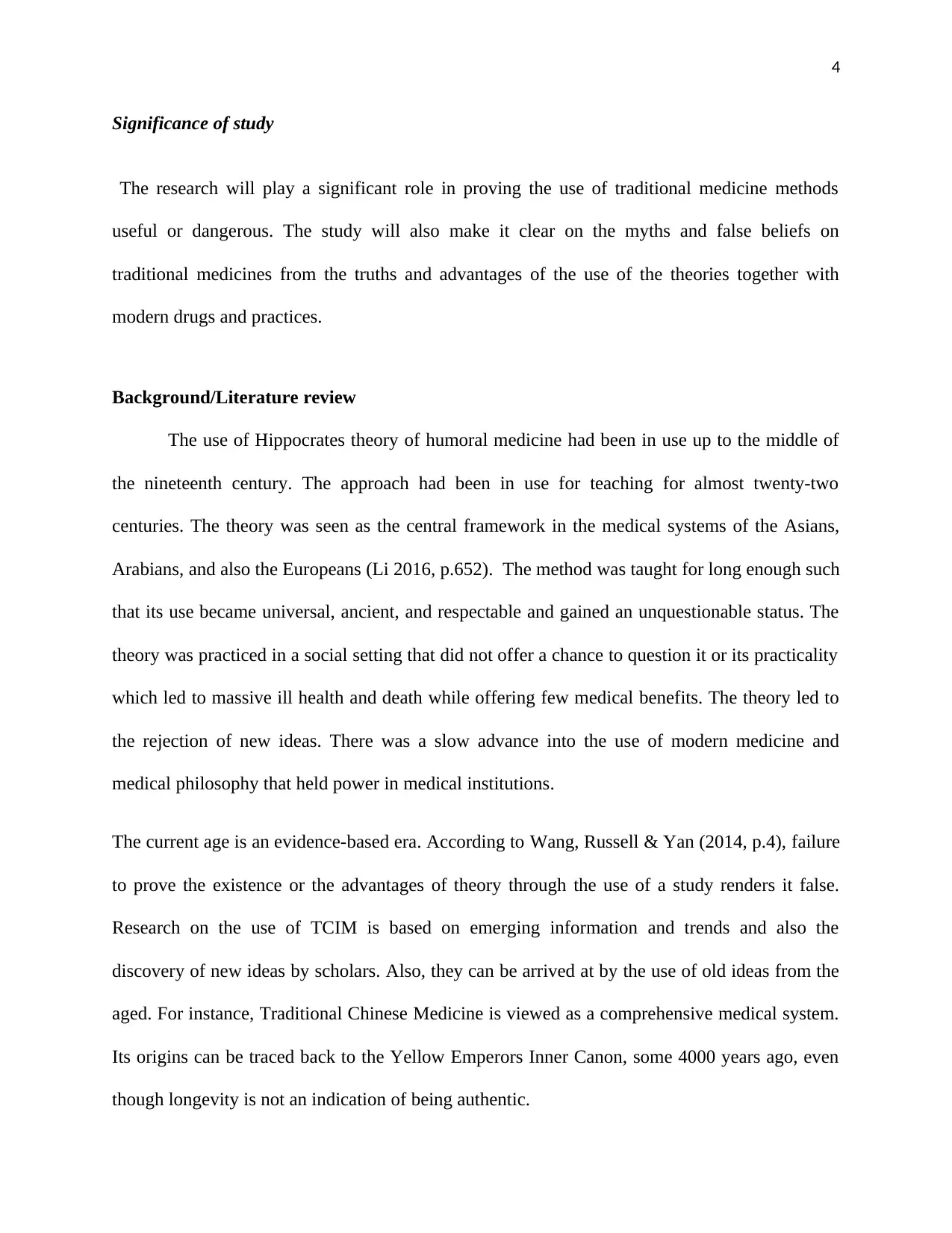
4
Significance of study
The research will play a significant role in proving the use of traditional medicine methods
useful or dangerous. The study will also make it clear on the myths and false beliefs on
traditional medicines from the truths and advantages of the use of the theories together with
modern drugs and practices.
Background/Literature review
The use of Hippocrates theory of humoral medicine had been in use up to the middle of
the nineteenth century. The approach had been in use for teaching for almost twenty-two
centuries. The theory was seen as the central framework in the medical systems of the Asians,
Arabians, and also the Europeans (Li 2016, p.652). The method was taught for long enough such
that its use became universal, ancient, and respectable and gained an unquestionable status. The
theory was practiced in a social setting that did not offer a chance to question it or its practicality
which led to massive ill health and death while offering few medical benefits. The theory led to
the rejection of new ideas. There was a slow advance into the use of modern medicine and
medical philosophy that held power in medical institutions.
The current age is an evidence-based era. According to Wang, Russell & Yan (2014, p.4), failure
to prove the existence or the advantages of theory through the use of a study renders it false.
Research on the use of TCIM is based on emerging information and trends and also the
discovery of new ideas by scholars. Also, they can be arrived at by the use of old ideas from the
aged. For instance, Traditional Chinese Medicine is viewed as a comprehensive medical system.
Its origins can be traced back to the Yellow Emperors Inner Canon, some 4000 years ago, even
though longevity is not an indication of being authentic.
Significance of study
The research will play a significant role in proving the use of traditional medicine methods
useful or dangerous. The study will also make it clear on the myths and false beliefs on
traditional medicines from the truths and advantages of the use of the theories together with
modern drugs and practices.
Background/Literature review
The use of Hippocrates theory of humoral medicine had been in use up to the middle of
the nineteenth century. The approach had been in use for teaching for almost twenty-two
centuries. The theory was seen as the central framework in the medical systems of the Asians,
Arabians, and also the Europeans (Li 2016, p.652). The method was taught for long enough such
that its use became universal, ancient, and respectable and gained an unquestionable status. The
theory was practiced in a social setting that did not offer a chance to question it or its practicality
which led to massive ill health and death while offering few medical benefits. The theory led to
the rejection of new ideas. There was a slow advance into the use of modern medicine and
medical philosophy that held power in medical institutions.
The current age is an evidence-based era. According to Wang, Russell & Yan (2014, p.4), failure
to prove the existence or the advantages of theory through the use of a study renders it false.
Research on the use of TCIM is based on emerging information and trends and also the
discovery of new ideas by scholars. Also, they can be arrived at by the use of old ideas from the
aged. For instance, Traditional Chinese Medicine is viewed as a comprehensive medical system.
Its origins can be traced back to the Yellow Emperors Inner Canon, some 4000 years ago, even
though longevity is not an indication of being authentic.
Paraphrase This Document
Need a fresh take? Get an instant paraphrase of this document with our AI Paraphraser
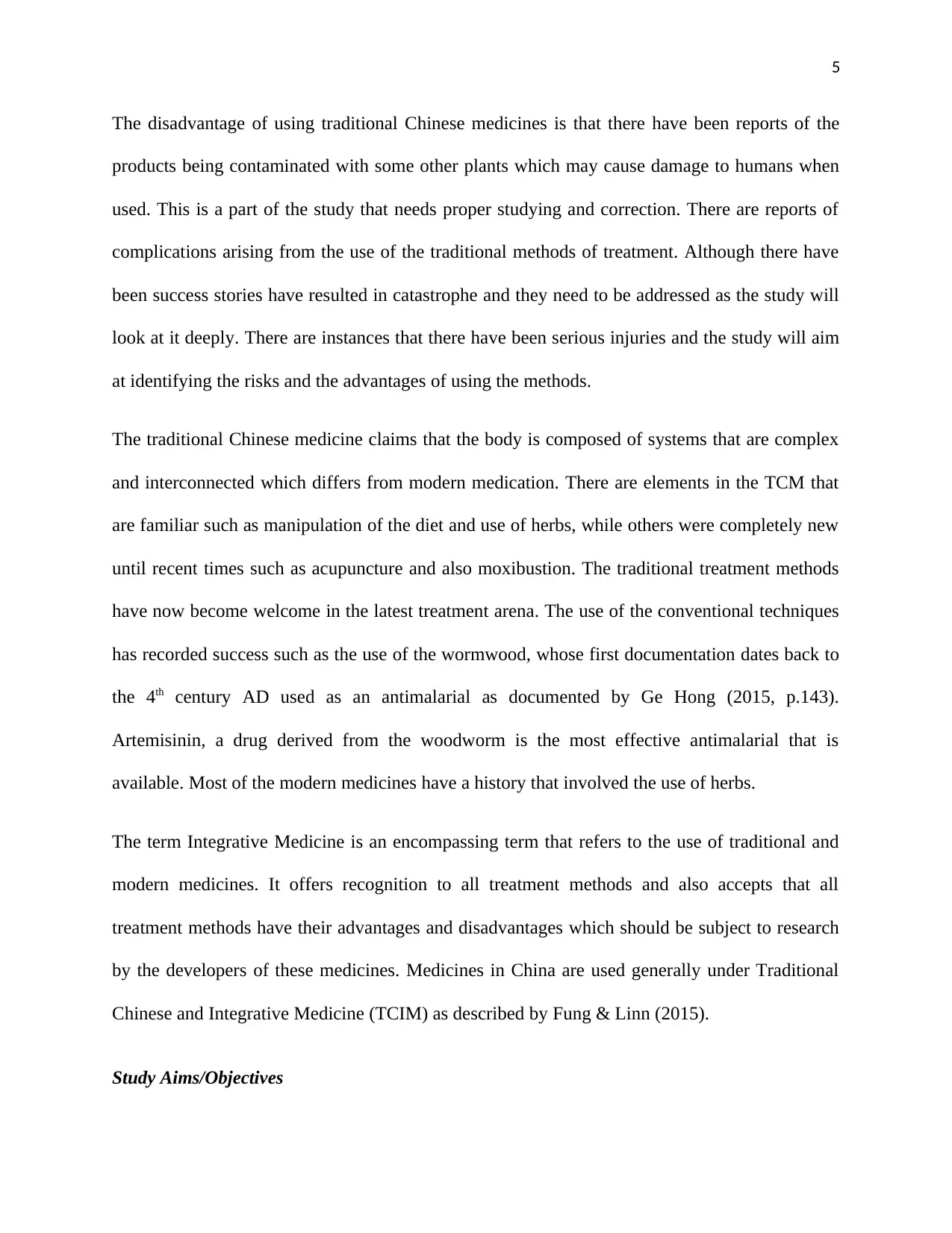
5
The disadvantage of using traditional Chinese medicines is that there have been reports of the
products being contaminated with some other plants which may cause damage to humans when
used. This is a part of the study that needs proper studying and correction. There are reports of
complications arising from the use of the traditional methods of treatment. Although there have
been success stories have resulted in catastrophe and they need to be addressed as the study will
look at it deeply. There are instances that there have been serious injuries and the study will aim
at identifying the risks and the advantages of using the methods.
The traditional Chinese medicine claims that the body is composed of systems that are complex
and interconnected which differs from modern medication. There are elements in the TCM that
are familiar such as manipulation of the diet and use of herbs, while others were completely new
until recent times such as acupuncture and also moxibustion. The traditional treatment methods
have now become welcome in the latest treatment arena. The use of the conventional techniques
has recorded success such as the use of the wormwood, whose first documentation dates back to
the 4th century AD used as an antimalarial as documented by Ge Hong (2015, p.143).
Artemisinin, a drug derived from the woodworm is the most effective antimalarial that is
available. Most of the modern medicines have a history that involved the use of herbs.
The term Integrative Medicine is an encompassing term that refers to the use of traditional and
modern medicines. It offers recognition to all treatment methods and also accepts that all
treatment methods have their advantages and disadvantages which should be subject to research
by the developers of these medicines. Medicines in China are used generally under Traditional
Chinese and Integrative Medicine (TCIM) as described by Fung & Linn (2015).
Study Aims/Objectives
The disadvantage of using traditional Chinese medicines is that there have been reports of the
products being contaminated with some other plants which may cause damage to humans when
used. This is a part of the study that needs proper studying and correction. There are reports of
complications arising from the use of the traditional methods of treatment. Although there have
been success stories have resulted in catastrophe and they need to be addressed as the study will
look at it deeply. There are instances that there have been serious injuries and the study will aim
at identifying the risks and the advantages of using the methods.
The traditional Chinese medicine claims that the body is composed of systems that are complex
and interconnected which differs from modern medication. There are elements in the TCM that
are familiar such as manipulation of the diet and use of herbs, while others were completely new
until recent times such as acupuncture and also moxibustion. The traditional treatment methods
have now become welcome in the latest treatment arena. The use of the conventional techniques
has recorded success such as the use of the wormwood, whose first documentation dates back to
the 4th century AD used as an antimalarial as documented by Ge Hong (2015, p.143).
Artemisinin, a drug derived from the woodworm is the most effective antimalarial that is
available. Most of the modern medicines have a history that involved the use of herbs.
The term Integrative Medicine is an encompassing term that refers to the use of traditional and
modern medicines. It offers recognition to all treatment methods and also accepts that all
treatment methods have their advantages and disadvantages which should be subject to research
by the developers of these medicines. Medicines in China are used generally under Traditional
Chinese and Integrative Medicine (TCIM) as described by Fung & Linn (2015).
Study Aims/Objectives
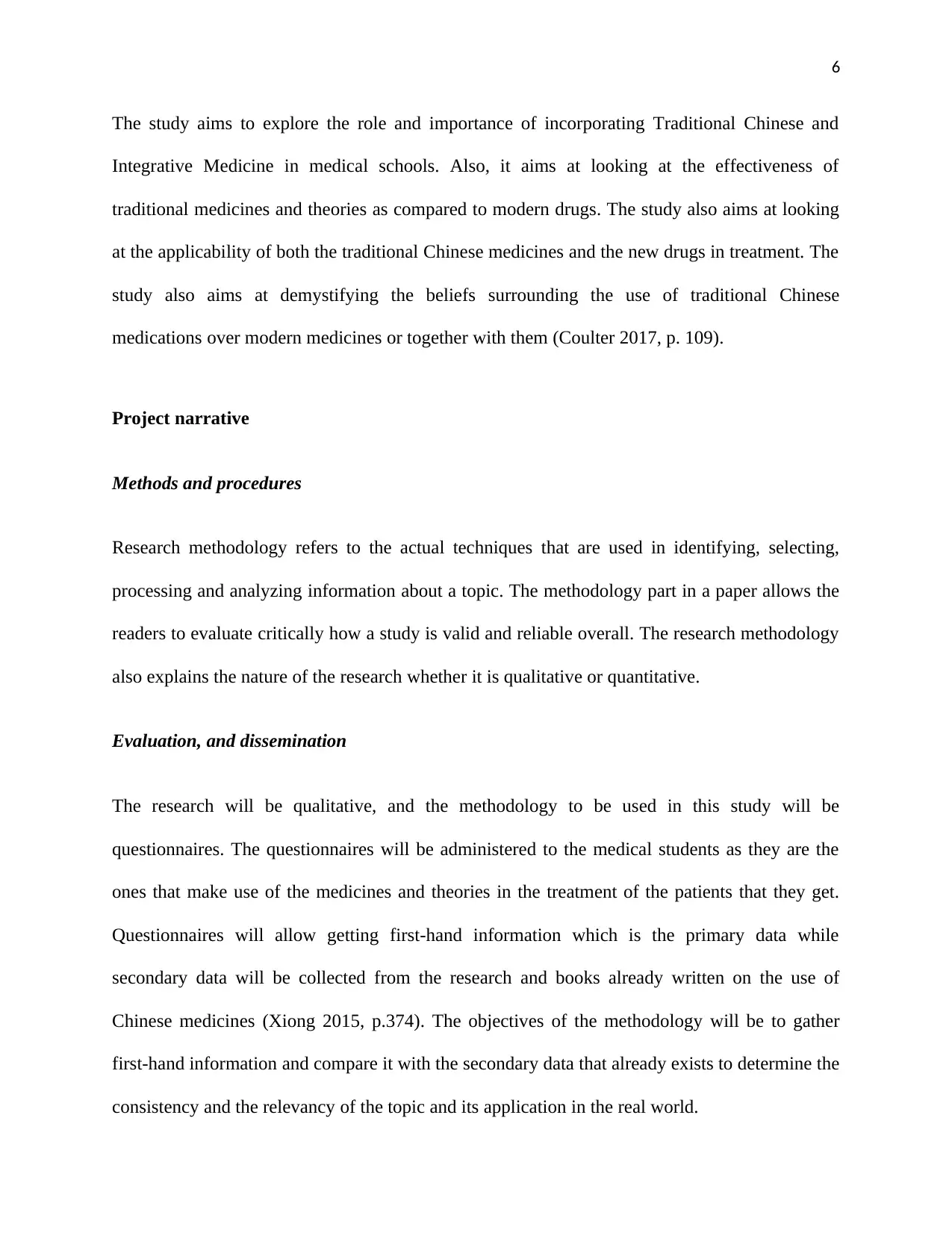
6
The study aims to explore the role and importance of incorporating Traditional Chinese and
Integrative Medicine in medical schools. Also, it aims at looking at the effectiveness of
traditional medicines and theories as compared to modern drugs. The study also aims at looking
at the applicability of both the traditional Chinese medicines and the new drugs in treatment. The
study also aims at demystifying the beliefs surrounding the use of traditional Chinese
medications over modern medicines or together with them (Coulter 2017, p. 109).
Project narrative
Methods and procedures
Research methodology refers to the actual techniques that are used in identifying, selecting,
processing and analyzing information about a topic. The methodology part in a paper allows the
readers to evaluate critically how a study is valid and reliable overall. The research methodology
also explains the nature of the research whether it is qualitative or quantitative.
Evaluation, and dissemination
The research will be qualitative, and the methodology to be used in this study will be
questionnaires. The questionnaires will be administered to the medical students as they are the
ones that make use of the medicines and theories in the treatment of the patients that they get.
Questionnaires will allow getting first-hand information which is the primary data while
secondary data will be collected from the research and books already written on the use of
Chinese medicines (Xiong 2015, p.374). The objectives of the methodology will be to gather
first-hand information and compare it with the secondary data that already exists to determine the
consistency and the relevancy of the topic and its application in the real world.
The study aims to explore the role and importance of incorporating Traditional Chinese and
Integrative Medicine in medical schools. Also, it aims at looking at the effectiveness of
traditional medicines and theories as compared to modern drugs. The study also aims at looking
at the applicability of both the traditional Chinese medicines and the new drugs in treatment. The
study also aims at demystifying the beliefs surrounding the use of traditional Chinese
medications over modern medicines or together with them (Coulter 2017, p. 109).
Project narrative
Methods and procedures
Research methodology refers to the actual techniques that are used in identifying, selecting,
processing and analyzing information about a topic. The methodology part in a paper allows the
readers to evaluate critically how a study is valid and reliable overall. The research methodology
also explains the nature of the research whether it is qualitative or quantitative.
Evaluation, and dissemination
The research will be qualitative, and the methodology to be used in this study will be
questionnaires. The questionnaires will be administered to the medical students as they are the
ones that make use of the medicines and theories in the treatment of the patients that they get.
Questionnaires will allow getting first-hand information which is the primary data while
secondary data will be collected from the research and books already written on the use of
Chinese medicines (Xiong 2015, p.374). The objectives of the methodology will be to gather
first-hand information and compare it with the secondary data that already exists to determine the
consistency and the relevancy of the topic and its application in the real world.
⊘ This is a preview!⊘
Do you want full access?
Subscribe today to unlock all pages.

Trusted by 1+ million students worldwide
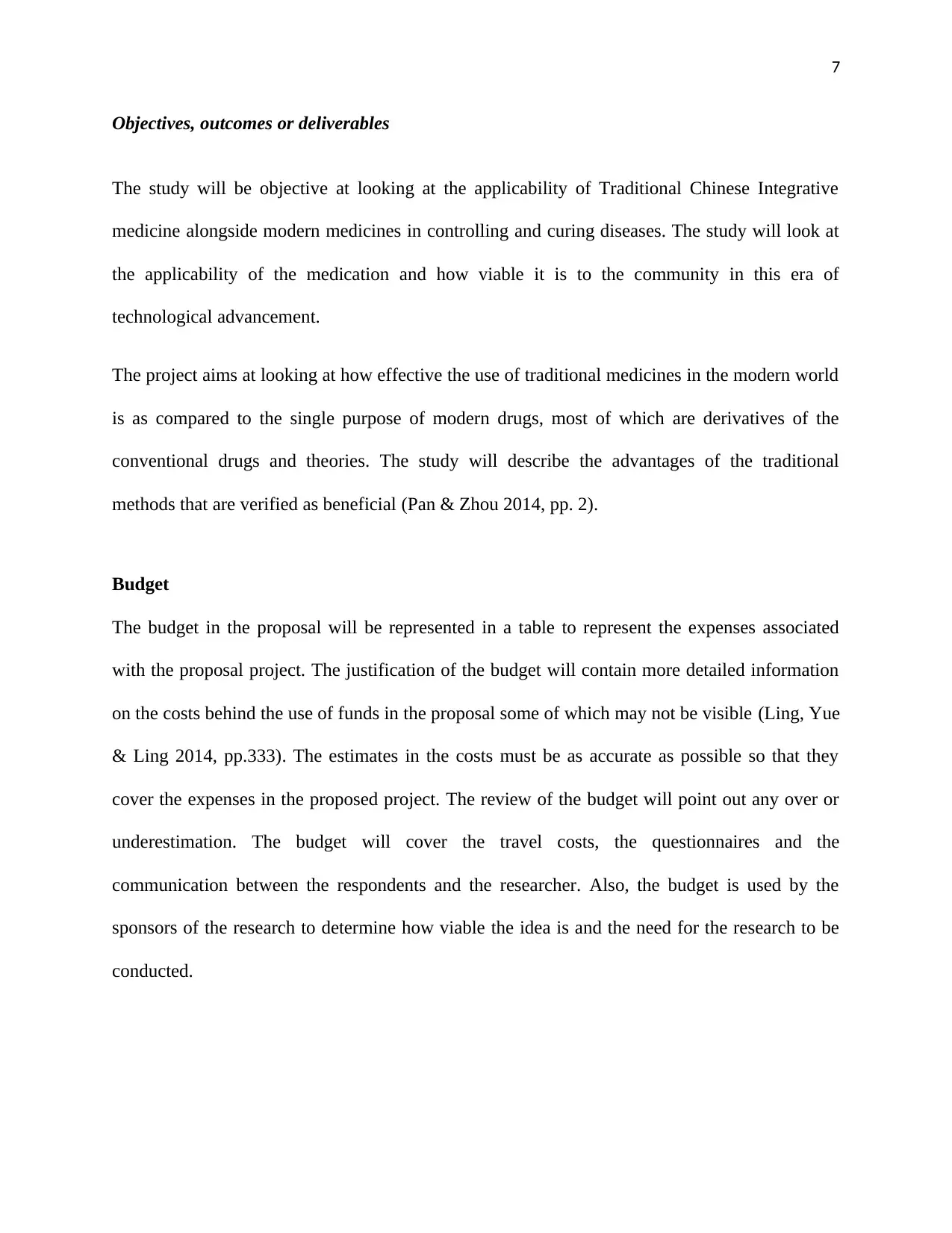
7
Objectives, outcomes or deliverables
The study will be objective at looking at the applicability of Traditional Chinese Integrative
medicine alongside modern medicines in controlling and curing diseases. The study will look at
the applicability of the medication and how viable it is to the community in this era of
technological advancement.
The project aims at looking at how effective the use of traditional medicines in the modern world
is as compared to the single purpose of modern drugs, most of which are derivatives of the
conventional drugs and theories. The study will describe the advantages of the traditional
methods that are verified as beneficial (Pan & Zhou 2014, pp. 2).
Budget
The budget in the proposal will be represented in a table to represent the expenses associated
with the proposal project. The justification of the budget will contain more detailed information
on the costs behind the use of funds in the proposal some of which may not be visible (Ling, Yue
& Ling 2014, pp.333). The estimates in the costs must be as accurate as possible so that they
cover the expenses in the proposed project. The review of the budget will point out any over or
underestimation. The budget will cover the travel costs, the questionnaires and the
communication between the respondents and the researcher. Also, the budget is used by the
sponsors of the research to determine how viable the idea is and the need for the research to be
conducted.
Objectives, outcomes or deliverables
The study will be objective at looking at the applicability of Traditional Chinese Integrative
medicine alongside modern medicines in controlling and curing diseases. The study will look at
the applicability of the medication and how viable it is to the community in this era of
technological advancement.
The project aims at looking at how effective the use of traditional medicines in the modern world
is as compared to the single purpose of modern drugs, most of which are derivatives of the
conventional drugs and theories. The study will describe the advantages of the traditional
methods that are verified as beneficial (Pan & Zhou 2014, pp. 2).
Budget
The budget in the proposal will be represented in a table to represent the expenses associated
with the proposal project. The justification of the budget will contain more detailed information
on the costs behind the use of funds in the proposal some of which may not be visible (Ling, Yue
& Ling 2014, pp.333). The estimates in the costs must be as accurate as possible so that they
cover the expenses in the proposed project. The review of the budget will point out any over or
underestimation. The budget will cover the travel costs, the questionnaires and the
communication between the respondents and the researcher. Also, the budget is used by the
sponsors of the research to determine how viable the idea is and the need for the research to be
conducted.
Paraphrase This Document
Need a fresh take? Get an instant paraphrase of this document with our AI Paraphraser
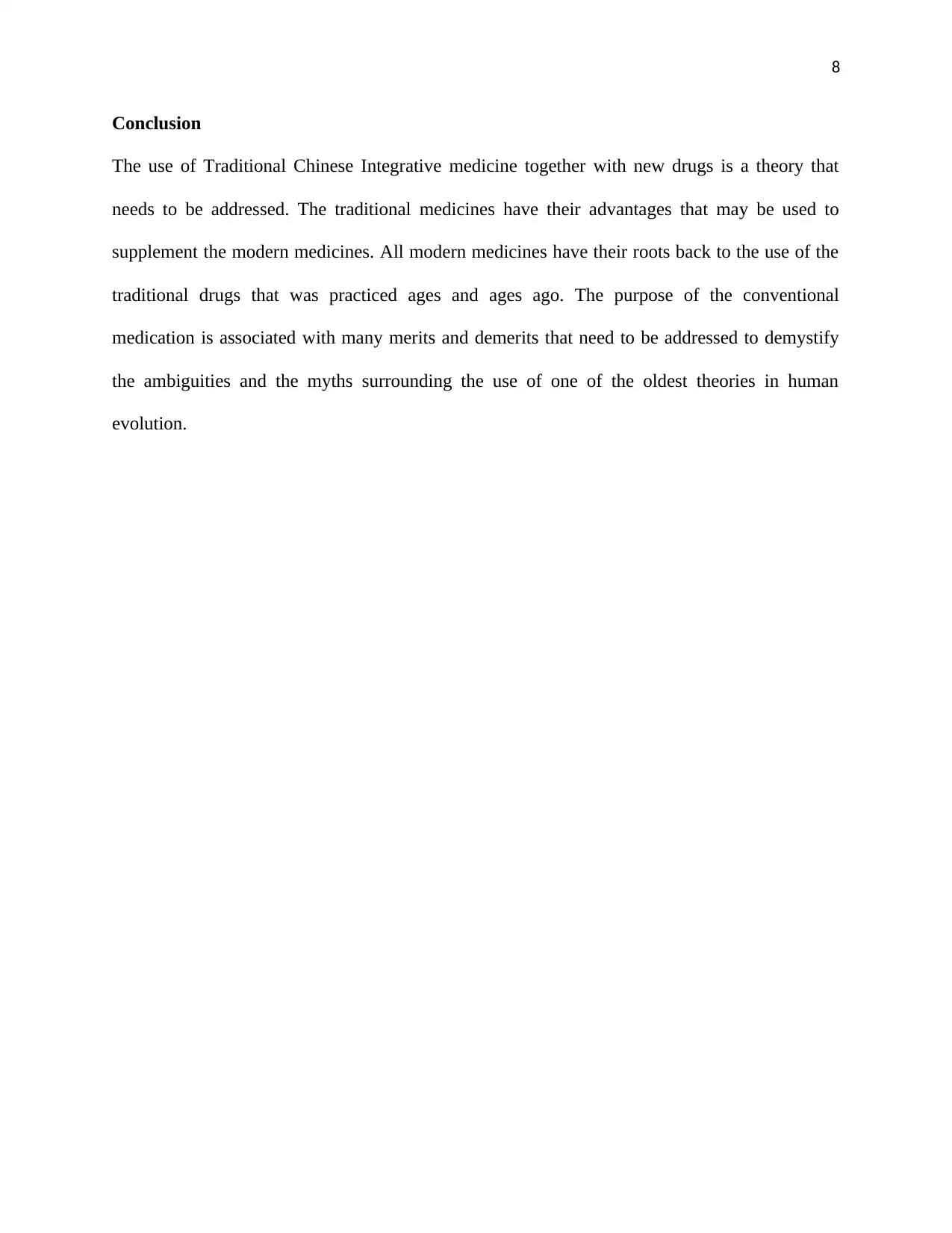
8
Conclusion
The use of Traditional Chinese Integrative medicine together with new drugs is a theory that
needs to be addressed. The traditional medicines have their advantages that may be used to
supplement the modern medicines. All modern medicines have their roots back to the use of the
traditional drugs that was practiced ages and ages ago. The purpose of the conventional
medication is associated with many merits and demerits that need to be addressed to demystify
the ambiguities and the myths surrounding the use of one of the oldest theories in human
evolution.
Conclusion
The use of Traditional Chinese Integrative medicine together with new drugs is a theory that
needs to be addressed. The traditional medicines have their advantages that may be used to
supplement the modern medicines. All modern medicines have their roots back to the use of the
traditional drugs that was practiced ages and ages ago. The purpose of the conventional
medication is associated with many merits and demerits that need to be addressed to demystify
the ambiguities and the myths surrounding the use of one of the oldest theories in human
evolution.
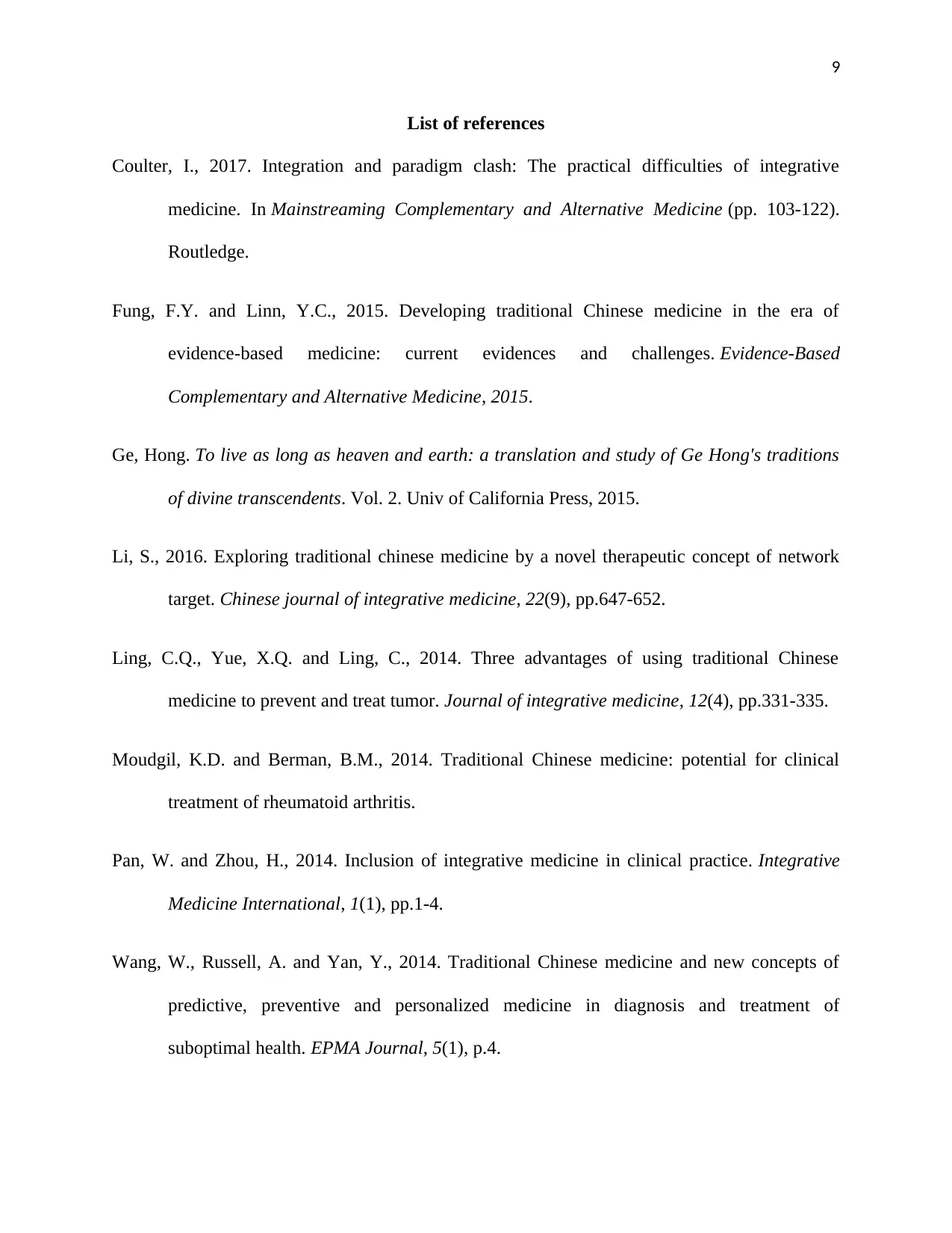
9
List of references
Coulter, I., 2017. Integration and paradigm clash: The practical difficulties of integrative
medicine. In Mainstreaming Complementary and Alternative Medicine (pp. 103-122).
Routledge.
Fung, F.Y. and Linn, Y.C., 2015. Developing traditional Chinese medicine in the era of
evidence-based medicine: current evidences and challenges. Evidence-Based
Complementary and Alternative Medicine, 2015.
Ge, Hong. To live as long as heaven and earth: a translation and study of Ge Hong's traditions
of divine transcendents. Vol. 2. Univ of California Press, 2015.
Li, S., 2016. Exploring traditional chinese medicine by a novel therapeutic concept of network
target. Chinese journal of integrative medicine, 22(9), pp.647-652.
Ling, C.Q., Yue, X.Q. and Ling, C., 2014. Three advantages of using traditional Chinese
medicine to prevent and treat tumor. Journal of integrative medicine, 12(4), pp.331-335.
Moudgil, K.D. and Berman, B.M., 2014. Traditional Chinese medicine: potential for clinical
treatment of rheumatoid arthritis.
Pan, W. and Zhou, H., 2014. Inclusion of integrative medicine in clinical practice. Integrative
Medicine International, 1(1), pp.1-4.
Wang, W., Russell, A. and Yan, Y., 2014. Traditional Chinese medicine and new concepts of
predictive, preventive and personalized medicine in diagnosis and treatment of
suboptimal health. EPMA Journal, 5(1), p.4.
List of references
Coulter, I., 2017. Integration and paradigm clash: The practical difficulties of integrative
medicine. In Mainstreaming Complementary and Alternative Medicine (pp. 103-122).
Routledge.
Fung, F.Y. and Linn, Y.C., 2015. Developing traditional Chinese medicine in the era of
evidence-based medicine: current evidences and challenges. Evidence-Based
Complementary and Alternative Medicine, 2015.
Ge, Hong. To live as long as heaven and earth: a translation and study of Ge Hong's traditions
of divine transcendents. Vol. 2. Univ of California Press, 2015.
Li, S., 2016. Exploring traditional chinese medicine by a novel therapeutic concept of network
target. Chinese journal of integrative medicine, 22(9), pp.647-652.
Ling, C.Q., Yue, X.Q. and Ling, C., 2014. Three advantages of using traditional Chinese
medicine to prevent and treat tumor. Journal of integrative medicine, 12(4), pp.331-335.
Moudgil, K.D. and Berman, B.M., 2014. Traditional Chinese medicine: potential for clinical
treatment of rheumatoid arthritis.
Pan, W. and Zhou, H., 2014. Inclusion of integrative medicine in clinical practice. Integrative
Medicine International, 1(1), pp.1-4.
Wang, W., Russell, A. and Yan, Y., 2014. Traditional Chinese medicine and new concepts of
predictive, preventive and personalized medicine in diagnosis and treatment of
suboptimal health. EPMA Journal, 5(1), p.4.
⊘ This is a preview!⊘
Do you want full access?
Subscribe today to unlock all pages.

Trusted by 1+ million students worldwide
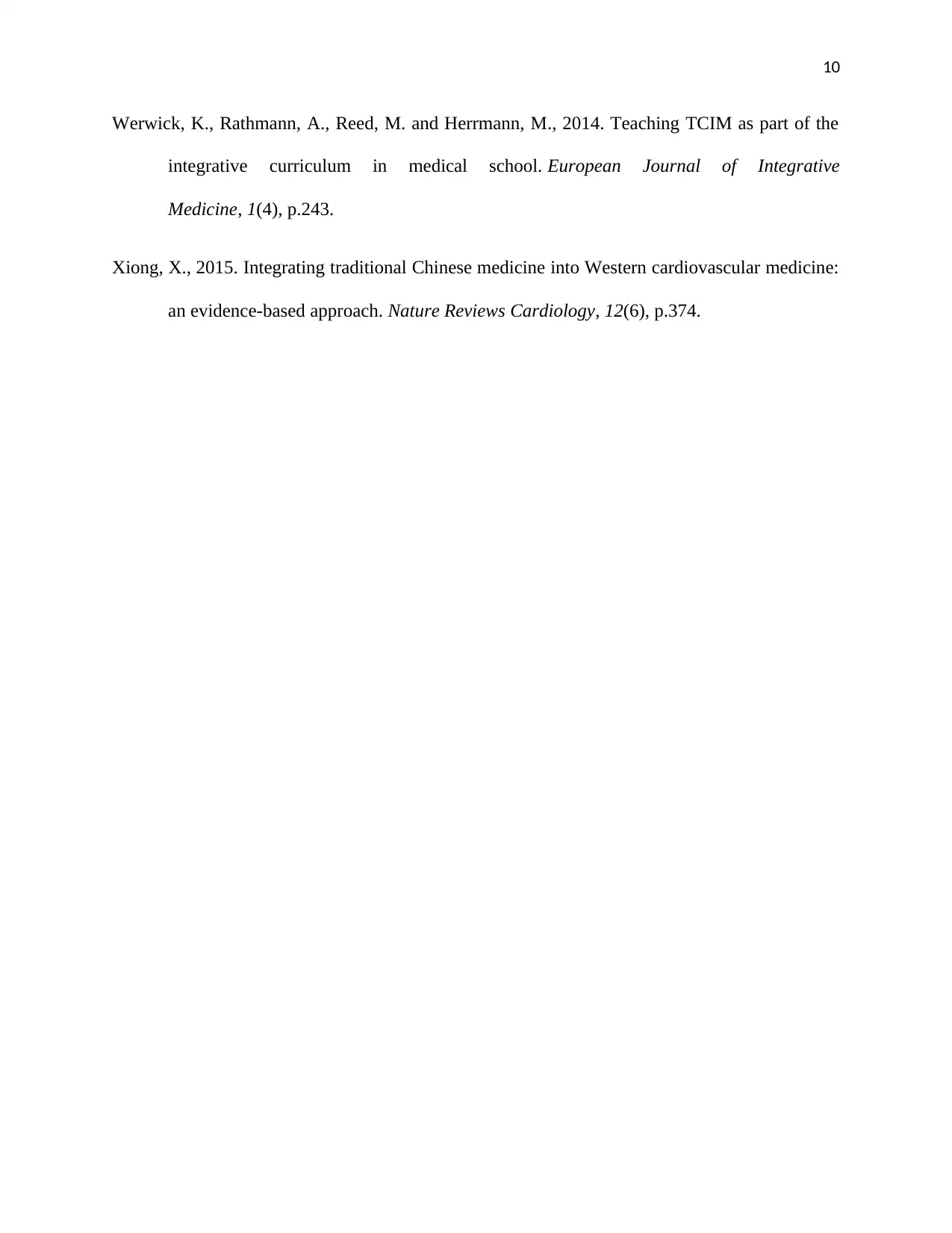
10
Werwick, K., Rathmann, A., Reed, M. and Herrmann, M., 2014. Teaching TCIM as part of the
integrative curriculum in medical school. European Journal of Integrative
Medicine, 1(4), p.243.
Xiong, X., 2015. Integrating traditional Chinese medicine into Western cardiovascular medicine:
an evidence-based approach. Nature Reviews Cardiology, 12(6), p.374.
Werwick, K., Rathmann, A., Reed, M. and Herrmann, M., 2014. Teaching TCIM as part of the
integrative curriculum in medical school. European Journal of Integrative
Medicine, 1(4), p.243.
Xiong, X., 2015. Integrating traditional Chinese medicine into Western cardiovascular medicine:
an evidence-based approach. Nature Reviews Cardiology, 12(6), p.374.
1 out of 10
Related Documents
Your All-in-One AI-Powered Toolkit for Academic Success.
+13062052269
info@desklib.com
Available 24*7 on WhatsApp / Email
![[object Object]](/_next/static/media/star-bottom.7253800d.svg)
Unlock your academic potential
Copyright © 2020–2025 A2Z Services. All Rights Reserved. Developed and managed by ZUCOL.





